By Jerry Low.
When it comes to finding new blog post ideas, it is important to not only write but to write things that people actually want to read. If you are producing blog posts that don’t appeal to anyone, then you are really just wasting your time. There are some key strategies you can use to ensure your blog posts are timely and have the potential to go viral.
Strategy #1: Google Analytics + Your Blog
The main idea with this strategy is “continual improvement”. The term comes from the engineering field and is the core principle in Total Quality Management. This is basically where a company improves manufacturing and business operations by continuously viewing data analysis and making adjustments. The goal is to improve everything from processes, to services, to the work environment itself.
These same concepts can be applied in the content strategy for your blog.
To do so, use Google Analytics to identify the type of content that’s already working on your blog and then make that content even better.
Google Analytics provides some strong insight into your blog and your audience. If you haven’t installed Google Analytics on your blog, adding Analytics should be your first task to improve on what you’re already doing. One of the best insights you’ll get from Google Analytics is discovering which posts your audience already loves.
How?
One simple way to see how your audience is reacting to your content is to go to: Dashboard > Behavior > Behavior Flow > Site Content > All Pages
Now, look at the top 25 to 50 pages. Compare the average time spent on each page and the bounce rate. If you notice that some pages hold your audience longer than others, this is what your audience is most interested in.
For example, below are our top 10 blog posts for Web Hosting Secrets Reveaked for January 2016. The post about Facebook plugins is holding the audience longer than the average. This means that the audience finds this info useful. In fact, they are spending 100% more time on that post than on some others.
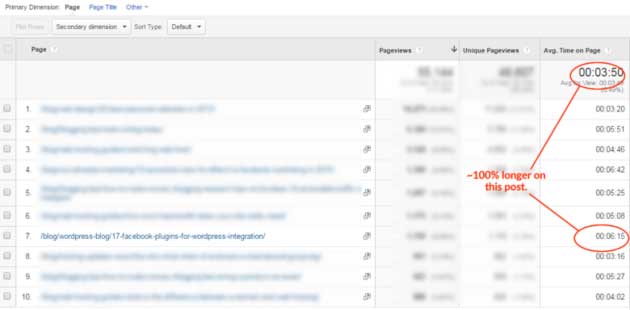
The Facebook plugin post is doing about 100% better than my average. Time to find out what makes it work so well and “amp up” the content.
What you should do is to “amp up” this content to the next level. Using the example above, I know people are really interested in Facebook Plugins. So, perhaps I could cover a few more similar plugins in the roundup or dig deeper into the topic. For example, I could run a detailed comparison among the top 5 Facebook Plugins or do some split testing and share the results.
Strategy #2: Convert popular non-text content into blogposts (Podcast / YouTube / Slideshare)
Another idea for blog posts that will attract attention is to draw on what is already popular out in the World Wide Web. For example, if a podcast is getting a lot of traction, then link to it and add your own thoughts on the topic.
Be creative. You can find non-text content related to your topic and embed into your blog post or create an entire post about that content. YouTube and SlideShare are both places where you can find interesting content and draw it into your overall roundups. So, how do you figure out what is popular?
On iTunes: Popularity Search
On iTunes, you can browse podcasts based on popularity. Go to the category related to your niche and see what ranks highest with listeners. Go to iTunes Store> Podcast> Search. Now, think about whether you can turn this topic into a blog post. If you can, then do so.
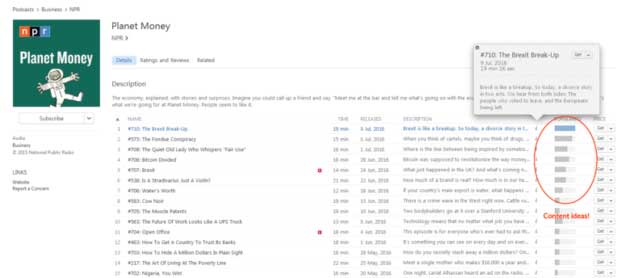
Real life sample: Planet Money podcasts, ranked according to popularity.
Do a search and then sort by popularity. Note that if you look at Planet Money that the most popular podcast from Planet Money is about the history of coding and women coders. Kind of unique and perhaps not what you expected, but you could easily turn this topic into an interesting blog post, perhaps interview a female coder, and then link to that podcast to give credit where credit is due.
On YouTube: Popularity Search & vidIQ
YouTube is another excellent source for ideas and linkable content. Use YouTube to see what vloggers in your niche are doing particularly well. You can easily search by keyword and see which videos come up first and which are most popular in that channel. Then, just like you did with iTunes podcasts, simply turn those general ideas into specific blog posts. You’ll already have a video to highlight/embed when you complete your post.

Some videos perform way better than the rest in vlogger’s channel. Why? Can you produce something similar in text/post. (Tip: Don’t forget to link back to the videos from your post – a simple “as inspired by video link” would be good).
You can also use vidIQ Chrome Extension to better understand how a particular YouTube video performs as far as Likes/Dislikes and social share counts.

VidIQ in action. The tool gives a clear breakdown of the tags (keywords) used and how many people find this slideshow interesting.
On SlideShare: Most Popular Page
SlideShare is another excellent source for both gathering ideas of popular topics and finding supporting media to add into your posts. You can find the most popular slides at SlideShare by going to the “Most Popular” page.
Make sure that the slideshow is set so that you can embed it on your site and then turn the concept into your own blog post. Even if you can’t embed it, you can still cover the topic and include a link to the slideshow if it enhances your article. Note how in the example below, a popular slideshow is on the topic of what happened before history.
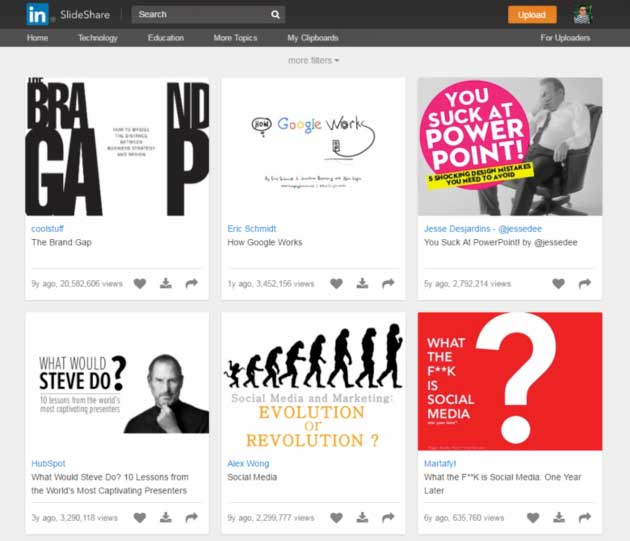
Here are some popular slides on SlideShare.net. I’m already seeing a new idea for my next blog post. “What Would Steve Do? 10 Blogging Lessons I learned from the World’s Most Captivating Presenters.” I can then include this presentation and what lesson I learned from it.
Strategy #3: Quora
The best content ideas are actually answers, but first you have to find the right question. When it comes to finding a question you can answer for your readers, Quora is a gold mine.
There are three simple ways to utilize what Quora has to offer.
Method #1. Just Read
When you read articles, you will gain ideas from your reading material. Perhaps there is a question you have that isn’t answered and you want to answer it with a post of your own. The Q&A website is a great platform to read and to learn from others. Quora is easy to use because the focus is simply reading through questions and the answers. The community has always surprised me not only with their level of expertise but their enthusiasm for a given topic.
For example, if you are writing a travel blog, here is a question you can pose and some ideas you might come up with: “What things do Chinese people find strange about the West?” Then you simply answer the question. Some topics you might generate would be: Too Tanned or Not: Why East and West See Sunbathing Differently and Must Visit Clubs in New York City for First-Time Chinese Travelers.
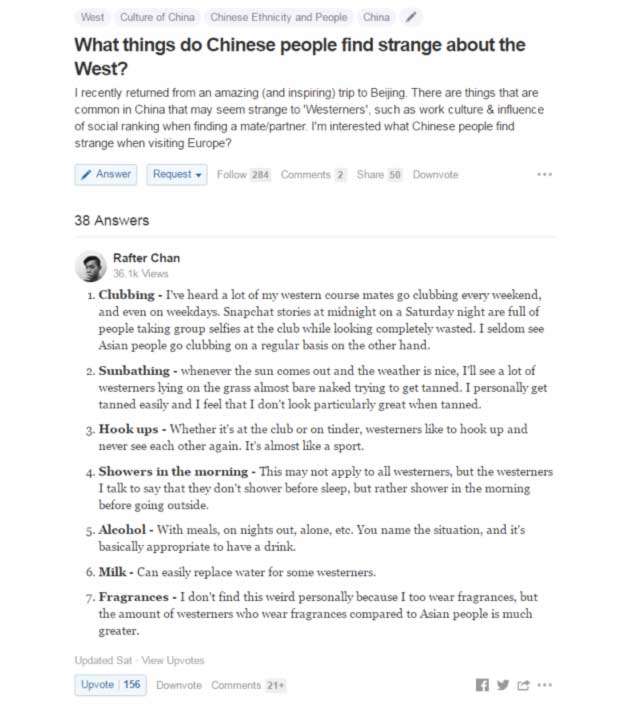
On Quora: What things do Chinese people find strange about the West?
Methods #2. Analyze Submitted Questions
Quora gives you the ability to find a question of interest and then follow it. You’ll then be notified when there is a new answer. New answers might further generate ideas or articles you can write on the topic. Questions with a lot of follows tend to gather a lot of answers and upvotes. You can learn the overall tone you should adopt for your blog post on the topic. If there are a lot of upvotes for an answer, then people regarded that answer in a positive light.
So, if you have your topic in mind, head over to Quora and do a search or that topic. Or, you can visit Quora’s sitemap. So, you could go to the sitemap, find your content category and then find which questions were most popular and also which answers within those questions. For example, I searched for “blogging” in image 2. Already, I have some good ideas just from that first page.

On Quora: What are the good ways to find a good domain name?
Method #3. Quora Trending Now
When you reach your user home page, you will see currently trending topics. Or, you can go direction to Trending Topics. Understand that these topics will often be timely, so use this when you can write a quick blog post and get it up fast. Some topics have a short shelf lie, so also think about whether or not you can keep the post evergreen enough to be valuable after the trend shifts.
Strategy #4: What’s Trending on Twitter
Some days, the trending topics on Twitter seem pretty random. Not everything that is trending is going to be relevant to your niche. However, you can still generate new blogging ideas from what is trending.
At WHSR, we have been able to leverage our growth with a content strategy that merges our primary niche (blogging, web hosting, marketing) with trending topics (Dungeon Master, Shark Tank TV series, gardening, etc.).
There are many benefits to marrying two very different topics, such as:
- Attracting a new audience who otherwise might not have read your blog.
- Making current readers think about an old topic in a new way.
- Benefiting from social media traffic and online chatter on the trending topic.
You should repeat our success by marrying your topic with subjects that are trending on Twitter. There are a few tools you can use to discover what is trending on Twitter.
1. Hashtags Tools
In a nutshell, a hashtag is simply the # symbol followed by a descriptive word or phrase. It is used to categorize topics or lead conversation around a specific topic. Anyone who searches for that particular hashtag will be able to locate posts centered around the topic.
Applications
Social tools like RiteTag and Hashtags.org help users identify trending hashtags and track trends related to them. One example might be the hashtag #MondayMotivation (see image below).
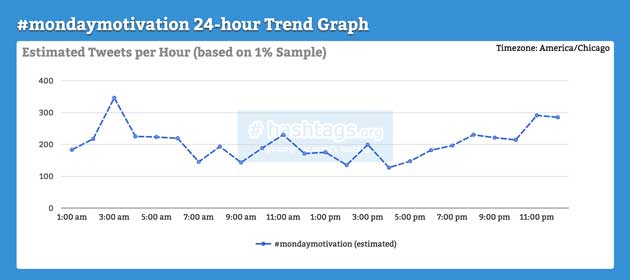
Trending cycle for #MondayMotivation.
You’ll find many different types of tweets associated with this hashtag. You’ll find images, blog posts and even videos. So, let’s say your blog is about cooking healthy. You simply write a post about starting over with healthier eating on Mondays and how to get motivated to do that and then hashtag it on Twitter. Simple right?
2. Trendsmap
Trendsmap shows you the latest trends on Twitter based on your geographic location. This can be particularly beneficial to small businesses that want to target customers in their area. To generate new content ideas that your local audience will want to read, just relate your subject to trending topics in your area and perhaps even nationally.
Applications
For example, “Pokemon” is trending like hot cakes. So, you could write a post about Pokemon in your city and then tie it into your niche as well.
Using the same example as above, let’s say you own a local health food store and a blog about healthier eating and exercise. So, you might write about “Exercising in Small Town, USA While Hunting for Pokemon.” You get the idea. Tie it into the trend, make it pertinent to your audience, and you’ll gain momentum.
Bottom line
These ideas will keep you busy writing blog posts for quite a while. You can also gain additional feedback by surveying your built-in audience, your regular site visitors. With a little bit of creativity and a lot of hard work, you can write topics that readers come to your site in droves to read.
Jerry Low is the founder of Web Hosting Secret Revealed (WHSR). You can find more blogging tips like this article in his ebook and bi-weekly newsletter service.
The post How to Find Blog Post Ideas That People Can’t Wait to Read appeared first on ProBlogger.
No comments:
Post a Comment